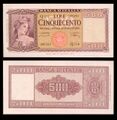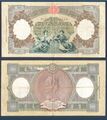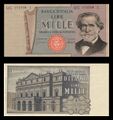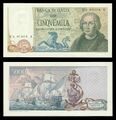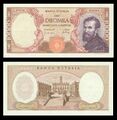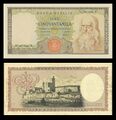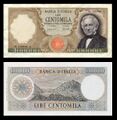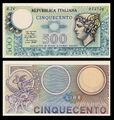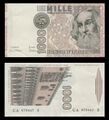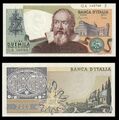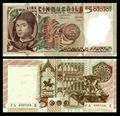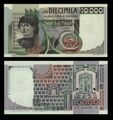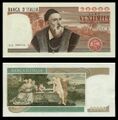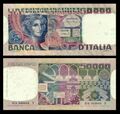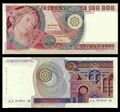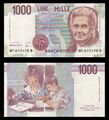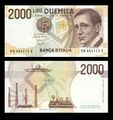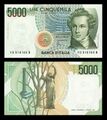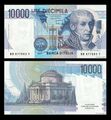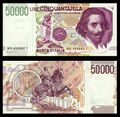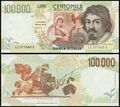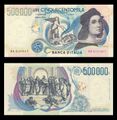ليرة إيطالية
| ليرة إيطالية | |||||
|---|---|---|---|---|---|
| Lira italiana (إيطالية) | |||||
| |||||
| ISO 4217 | |||||
| الكود | ITL | ||||
| الرقم | 380 | ||||
| الأس | 0 | ||||
| الفئات | |||||
| الوحدات الفرعية | |||||
| 1⁄100 | Centesimo (withdrawn after World War II) | ||||
| الجمع | lire | ||||
| Centesimo | centesimi | ||||
| الرمز | L. (most commonly) or £[1] (rarely) | ||||
| الأوراق النقدية | |||||
| شائع الاستخدام | L.1,000, L.2,000, L.5,000, L.10,000, L.50,000, L.100,000 | ||||
| نادر الاستخدام | L.500,000 | ||||
| العملات | |||||
| شائع الاستخدام | L.50, L.100, L.200, L.500, L.1,000 | ||||
| نادر الاستخدام | L.1, L.2, L.5, L.10, L.20 | ||||
| الديمغرافيا | |||||
| المستخدم(ون) |
| ||||
| الإصدار | |||||
| البنك المركزي | Banca d'Italia | ||||
| الموقع الإلكتروني | www | ||||
| الطباعة | Istituto Poligrafico e Zecca dello Stato | ||||
| الموقع الإلكتروني | www | ||||
| مصلحة صك العملة | Istituto Poligrafico e Zecca dello Stato | ||||
| الموقع الإلكتروني | www | ||||
| القيمة | |||||
| التضخم | 2.3% (2001) | ||||
| ERM | |||||
| منذ | 13 March 1979, 25 November 1996 | ||||
| مسحوب | 17 September 1992 | ||||
| Fixed rate since | 31 December 1998 | ||||
| Replaced by €, non cash | 1 January 1999 | ||||
| Replaced by €, cash | 1 March 2002 | ||||
| € = | L.1,936.27 | ||||
This infobox shows the latest status before this currency was rendered obsolete. | |||||
ليرة ( lira ؛ النطق بالإيطالية: [ˈliːra]; plural lire النطق بالإيطالية: [ˈliːre]) was the currency of Italy between 1861 and 2002. It was first introduced by the Napoleonic Kingdom of Italy in 1807 at par with the French franc, and was subsequently rolled out by the different states that would eventually form the Kingdom of Italy in 1861. It was subdivided into 100 centesimi (singular: centesimo), which means "hundredths" or "cents". The lira was also the currency of the Albanian Kingdom from 1941-1943.
The term originates from libra, the largest currency unit of the Carolingian monetary system used in Western Europe since the 8th century CE. From the same unit was derived the French livre tournois, the predecessor to both the French franc and Italian lira.
In 1999 the lira became officially a national subunit of the euro at the rate of €1 = 1,936.27 lire, before being finally replaced by euro coins and banknotes in 2002.
. . . . . . . . . . . . . . . . . . . . . . . . . . . . . . . . . . . . . . . . . . . . . . . . . . . . . . . . . . . . . . . . . . . . . . . . . . . . . . . . . . . . . . . . . . . . . . . . . . . . . . . . . . . . . . . . . . . . . . . . . . . . . . . . . . . . . . . . . . . . . . . . . . . . . . . . . . . . . . . . . . . . . . . .
التاريخ
أصل الاسم
The Carolingian monetary system divided the libra into 20 solidi (singular: solidus) or 240 denari (singular: denarius). These units translate in Italian to lira, soldo & denaro; in French to livre, sou & denier; and in English to pound, shilling & penny. Amounts in Italian lire were denoted by the symbols "L" or "£".
In France, the "franc" referred to a coin worth one livre tournois. This term was adopted in various Gallo-Italic languages in north-western Italy to also refer to the Italian lira.[2]
تقديم الليرة
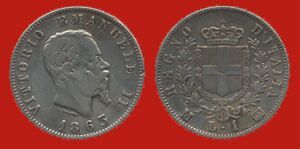
The Napoleonic Kingdom of Italy first introduced the Italian lira in 1807 at par with the French franc, worth 4.5 grams of fine silver or 0.29032 gram of fine gold (gold-silver ratio 15.5). Despite the kingdom's demise in 1814, this new lira would eventually replace the currencies of the different Italian states until their unification in 1861, replacing, among others:
- The Piedmontese scudo, Sardinian scudo and the Genoese lira after 1800, by the Italian lira;
- The Milanese lira, Venetian lira, Lombardy-Venetian lira and Parman lira after 1814, at the rate of 270 Milanese lire = 45 Milanese scudi = 405 Venetian lire = 855 Parman lire = 207.23 Italian lire;[3]
- The Tuscan fiorino and the Tuscan lira in 1859, at 1 francescone = 4 fiorini = 62⁄3 Tuscan lire = 5.6 Italian lire;
- The piastra of Naples and Sicily in 1861, at 1 piastra = 1.2 ducat di regno = 5.1 Neapolitan lire, the latter at par with the Italian lira; and
- The scudo of Rome and the Papal States in 1866, at 1 scudo = 5.375 Papal lire, the latter at par with the Italian lira.
In 1865, Italy formed part of the Latin Monetary Union in which the lira was set as equal to, among others, the French, Belgian and Swiss francs. The U.S. dollar was worth approximately 5.18 Italian lire until 1914.
القرن العشرون
World War I broke the Latin Monetary Union and resulted in prices rising severalfold in Italy. Inflation was curbed somewhat by Mussolini, who, on August 18, 1926, announced a new exchange rate between lira and Sterling of £1Stg = L.90—the so-called Quota 90, although the free exchange rate had been closer to L.140–L.150 per pound, causing a temporary deflation and widespread problems in the real economy. In 1927, the lira was pegged to the U.S. dollar at a rate of US$1 = L.19. This rate lasted until 1934, with a separate "tourist" rate of US$1 = L.24.89 being established in 1936. In 1939, the "official" rate was L.19.8.
After the Allied invasion of Italy, an exchange rate was set at US$1 = L.120 (£1Stg = L.480) in June 1943, reduced to L.100 the following month. In German-occupied areas, the exchange rate was set at RM1 = L.10. After the war, the value of the lira fluctuated, before Italy set a peg of US$1 = L.575 within the Bretton Woods System in November 1947. Following the devaluation of the pound, Italy devalued to US$1 = L.625 on 21 September 1949. This rate was maintained until the end of the Bretton Woods System in the early 1970s. Several episodes of high inflation followed until the introduction of the euro.
Redenomination
Although Italian price displays and calculations became unwieldy because of the large number of zeros, proposals to subtract 3 or 4 zeroes were unsuccessful for political reasons until the introduction of the euro.
تقديم اليورو
The lira was the official unit of currency in Italy until 1 January 1999, when it was replaced by the euro (the lira was officially a national subunit of the euro until the rollout of euro coins and notes in 2002). Old lira denominated currency ceased to be legal tender on 28 February 2002. The conversion rate is 1,936.27 lire to the euro.[4]
All lira banknotes in use immediately before the introduction of the euro, and all post-World War II coins, were exchanged by the Bank of Italy up to 6 December 2011. Originally, Italy's central bank pledged to redeem Italian coins and banknotes until 29 February 2012, but this was brought forward to 6 December 2011.
العملات المعدنية
Napoleonic coins
The Napoleonic Kingdom of Italy issued coins between 1807 and 1813 in denominations of 1 and 3 centesimi and 1 soldo (5 centesimi) in copper, 10 centesimi in 20% silver alloy, 5, 10 and 15 soldi (or 25, 50 and 75 centesimi), L.1, L.2 and L.5 in 90% silver and L.20 and L.40 in 90% gold. All except the 10 centesimi bore a portrait of Napoleon, with the denominations below 1 lira also showing a radiate crown and the higher denominations, a shield representing the various constituent territories of the Kingdom.
مملكة إيطاليا، 1861–1946
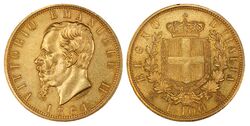
In 1861, coins were minted in Florence, Milan, Naples and Turin in denominations of 1c, 2c, 5c, 10c and 50c, L.1, L.2, L.5, L.10 and L.20, with the lowest four in copper, the highest two in gold and the remainder in silver. In 1863, silver coins below 5 lire were debased from 90% to 83.5% and silver 20-centesimi coins were introduced. Minting switched to Rome in the 1870s.
Apart from the introduction in 1894 of cupro-nickel (later nickel) 20-centesimi coins and of nickel 25-centesimi pieces in 1902, the coinage remained essentially unaltered until the First World War.
In 1919, with the purchasing power of the lira reduced to one fifth of that of 1914, the production of all earlier coin types except for the nickel 20c halted, and smaller, copper 5c and 10c and nickel 50c coins were introduced, followed by nickel L.1 and L.2 pieces in 1922 and 1923, respectively. In 1926, silver L.5 and L.10 coins were introduced, equal in size and composition to the earlier L.1 and L.2 coins. Silver L.20 coins were added in 1927.
In 1936, the last substantial issue of silver coins was made, whilst, in 1939, moves to reduce the cost of the coinage led to copper being replaced by aluminium bronze and nickel by stainless steel. All production of coinage halted in 1943.
In 1943 the AM-lira was issued, in circulation in Italy after the landing in Sicily on the night between 9 and 10 July 1943. After 1946, the AM-lira ceased to be the currency of employment and was used along with normal notes, until June 3, 1950.
Between 1947 and 1954, zone B of the Free Territory of Trieste used the Triestine lira.
Italian Republic, 1946–2002
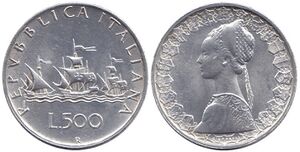
In 1946 coin production was resumed, although only in 1948, with the purchasing power of the lira reduced to 2% of that of 1939, did numbers minted exceed 1 million. To begin with, four denominations were issued in aluminium, L.1, L.2, L.5 and L.10: these coins were in circulation together with the AM-lire and some of the old, devalued coins of the Italian Kingdom. In 1951, the government decided to replace all the circulating coins and bills with new smaller-sized aluminium L.1, L.2, L.5 and L.10 (although the L.2 coin was not minted in 1951 or 1952) and in 1954–1955, Acmonital (stainless-steel) L.50 and L.100 coins were introduced, followed by aluminium-bronze L.20 in 1957 and silver L.500 in 1958. Increases in the silver bullion price led to the L.500 coins being produced only in small numbers for collectors after 1967. The L.500 (and later the L.1,000) also appeared in a number of commemorative coin issues, such as the centennial of Italian unification in 1961. Between 1967 and 1982, two types of "paper money" were issued with a value of L.500. These were not issued by "Banca d'Italia", but directly by the government bearing the title "Repubblica Italiana".
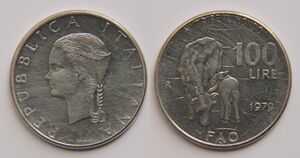
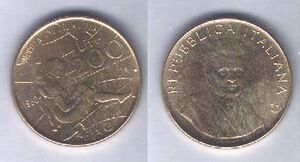
In 1977, aluminium-bronze L.200 coins were introduced, followed in 1982 by the bimetallic L.500. This was the first bi-metallic coin to be produced for circulation, minted using a system patented by IPZS. It was also the first to feature the value in braille.[5]
Production of L.1 and L.2 coins for circulation ceased in 1959; their mintage was restarted from 1982 to 2001 for collectors' coin sets. Production of the L.5 coin was greatly reduced in the late 1970s and ceased for circulation in 1998. Similarly, in 1991 the production of L.10 and L.20 coins was limited. The sizes of the L.50 and L.100 coins were reduced in 1990, but then they were completely redesigned 1993. A bimetallic L.1,000 coin was introduced in 1997 and stopped in 1998 due to the impending introduction of the euro.
Coins still being minted for circulation at the time of the changeover to euro (in 2000 and 2001 only lire for collectors coins sets were minted) were:[6]
- L.1 (0.05 cents, only for collectors)
- L.2 (0.10 cents, only for collectors)
- L.5 (0.26 cents, only for collectors)
- L.10 (0.52 cents, only for collectors)
- L.20 (1.03 cents, only for collectors)
- L.50 (2.58 cents)
- L.100 (5.16 cents)
- L.200 (10.33 cents)
- L.500 (25.82 cents)
- L.1,000 (51.65 cents)
. . . . . . . . . . . . . . . . . . . . . . . . . . . . . . . . . . . . . . . . . . . . . . . . . . . . . . . . . . . . . . . . . . . . . . . . . . . . . . . . . . . . . . . . . . . . . . . . . . . . . . . . . . . . . . . . . . . . . . . . . . . . . . . . . . . . . . . . . . . . . . . . . . . . . . . . . . . . . . . . . . . . . . . .
Banknotes
In 1882, the government began issuing low-denomination paper money bearing the title "Biglietto di Stato" (meaning "Ticket of the state"). To begin with, there were L.5 and L.10 notes, to which L.25 notes were occasionally added from 1895. The government also issued notes titled "Buono di Cassa" between 1893 and 1922 in denominations of L.1 and L.2. Production of Biglietti di Stato ceased in 1925 but resumed in 1935 with notes for L.1, L.2, L.5 and L.10 being introduced by 1939.
The Bank of Italy began producing paper money in 1896. To begin with, L.50, L.100, L.500 and L.1,000 notes were issued. In 1918–1919, L.25 notes were also issued but no other denominations were introduced until after the Second World War.
In 1943, the invading Allies introduced notes in denominations of L.1, L.2, L.5, L.10, L.50, L.100, L.500 and L.1,000. These were followed in 1944 by a series of Biglietti di Stato for L.1, L.2, L.5 and L.10, which circulated until replaced by coins in the late 1940s. The Bank of Italy introduced L.5,000 and L.10,000 notes in 1947 and 1948, respectively.
In 1951, the government again issued notes, this time simply bearing the title "Repubblica Italiana". Denominations were of L.50 and L.100 (replacing the Bank of Italy notes) and they circulated until coins of these denominations were introduced in the mid-1950s. In 1966, L.500 notes were introduced (again replacing Bank of Italy notes) which were produced until replaced in 1982 by a coin.
L.50,000 and L.100,000 notes were introduced by the Bank of Italy in 1967, followed by L.2,000 notes in 1973, L.20,000 notes in 1975 and L.500,000 notes in 1997.
In the mid-1970s, when coinage was in short supply, Italian banks printed "miniassegni" in L.50 and L.100 amounts. Technically bearer checks, they were printed in the form of banknotes and were generally accepted as substitute legal currency.
Notes in circulation when the euro was introduced were:
- L.1,000, Maria Montessori (€0.516)
- L.2,000, Guglielmo Marconi (€1.03)
- L.5,000, Vincenzo Bellini (€2.58)
- L.10,000, Alessandro Volta (€5.16)
- L.20,000, Tiziano Vecellio (€10.32) [7]
- L.50,000, Gian Lorenzo Bernini (€25.82)
- L.100,000, Caravaggio (€51.65)
- L.500,000, Raffaello (€258.23)
| Banknotes of the Italian lira (1990–1997 issues) | |||||||
|---|---|---|---|---|---|---|---|
| Image | Value | Dimension | Equivalent in euros (€) | Main color | Obverse | Reverse | Watermark |
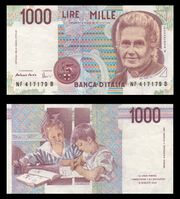
|
L.1,000 | 112 x 62 mm | €0.516 | Red-violet | Maria Montessori | Montessori education | Maria Montessori |
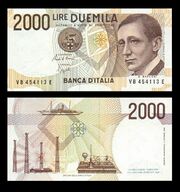
|
L.2,000 | 118 x 60 mm | €1.03 | Dark brown | Guglielmo Marconi | Marconi's yacht "Elettra"; Radio towers at Marconi's station Glace Bay in Nova Scotia; telegraph | Guglielmo Marconi |
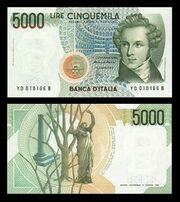
|
L.5,000 | 126 x 70 mm | €2.58 | Olive-green and blue | Vincenzo Bellini; interior of Teatro Massimo Bellini (Catania) | Scene from Bellini's opera "Norma"; Allegory of "Lyrics" | Vincenzo Bellini |
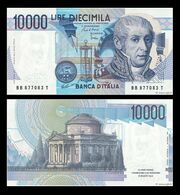
|
L.10,000 | 133 x 70 mm | €5.16 | Dark blue | Alessandro Volta; the Voltaic pile | The Tempio Voltiano Museum in Como | Alessandro Volta |
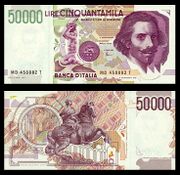
|
L.50,000 | 150 x 70 mm | €25.82 | Red-violet or Violet and dull green | Gian Lorenzo Bernini; Triton Fountain in Rome | Equestrian statue (by Bernini), interior of St. Peter's Basilica (Vatican City) | Gian Lorenzo Bernini |
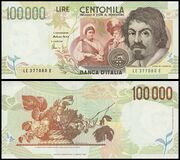
|
L.100,000 | 156 x 80 mm | €51.65 | Dark brown, reddish brown and pale green | Caravaggio, couple from Caravaggio's painting "The Fortune Teller" | Fruit basket in the background | Caravaggio (Michelangelo Merisi) |
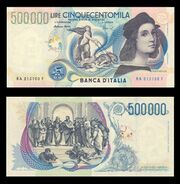
|
L.500,000 | 163 x 78 mm | €258.23 | Deep purple, dark blue and bright green | Raffaello; Triumph of Galatea | The School of Athens | Raphael |
Gallery
Vatican City
The Vatican lira (plural lire) was the official unit of the Vatican City State. It was at par with the Italian lira under the terms on the concordat with Italy. Italian lira notes and coins were legal tender in the Vatican City, and vice versa. Specific Vatican coins were minted in Rome, and were legal tender also in Italy and San Marino.
The Vatican City switched to the euro along with Italy and San Marino. As with old Vatican lira coins, the Vatican City has its own set of euro coins.
San Marino
The Sammarinese lira (plural lire) was the official unit of San Marino. Like the Vatican lira, the Sammarinese lira was at par with the Italian lira.
Italian lira notes and coins were legal tender in San Marino (and vice versa). Specific Sammarinese coins were minted in Rome, and were legal tender in Italy, as well as the Vatican City.
San Marino switched to the euro along with Italy and the Vatican City. As with old Sammarinese lira coins, the country has its own set of euro coins.
Miniassegno
Miniassegni (singular: miniassegno) were a special kind of money called notgeld that circulated in Italy in the late 1970s in place of change, as in that period small-denomination coins were scarce and were often replaced by candy, stamps, telephone tokens, and in some cities public transport tickets. The first miniassegni made their appearance in December 1975, and were subsequently issued by many banks; they had nominal values of L.50, L.100, L.150, L.200, L.250, L.300 and L.350.
Restoration
In 2005, the Lega Nord launched a campaign to reintroduce the lira as a parallel currency.[8] In 2014, Beppe Grillo, the Five Star Movement leader spearheaded a referendum bid, to restore the lira in Italy.[9]
انظر أيضاً
- Economy of Italy
- Italian euro coins
- Economy of San Marino
- Sammarinese euro coins
- Economy of Vatican City
- Vatican euro coins
. . . . . . . . . . . . . . . . . . . . . . . . . . . . . . . . . . . . . . . . . . . . . . . . . . . . . . . . . . . . . . . . . . . . . . . . . . . . . . . . . . . . . . . . . . . . . . . . . . . . . . . . . . . . . . . . . . . . . . . . . . . . . . . . . . . . . . . . . . . . . . . . . . . . . . . . . . . . . . . . . . . . . . . .
المراجع
- ^ In Unicode, the pound / lira symbol is unified as U+00A3 £ and whether this character has a single or double bar is merely considered a typographical variation of the same character. U+20A4 ₤ exists solely for compatibility with this character set, HP Roman-8, in which the singly barred glyph is coded as BB16 and the doubly barred glyph as AF16. https://www.unicode.org/versions/Unicode8.0.0/ch22.pdf
- ^ "Poesie e Prose in dialetto". www.dialettando.com. Archived from the original on 2019-07-02. Retrieved 2009-07-30.
- ^ Milan p 254; Parma p 275; Venice p 344. https://books.google.com/books?id=MJnPAAAAMAAJ&pg=PA344#v=onepage&q&f=false
- ^ Bank, European Central (31 December 1998). "Determination of the euro conversion rates". European Central Bank. Archived from the original on 2015-06-27. Retrieved 2015-06-26.
- ^ Krause, Chester L. and Clifford Mishler (1991). Standard Catalog of World Coins: 1801-1991 (18th ed. ed.). Krause Publications. ISBN 0-87341-150-1.
{{cite book}}:|edition=has extra text (help) - ^ "Libero - Community - I siti personali". digilander.libero.it.
- ^ This note was issued briefly in 1975, with a limited reprinting in 1985, so there were few of them in circulation
- ^ "Northern League launch campaign to revive lira". euobserver.com. Archived from the original on 2014-10-21. Retrieved 2014-10-17.
- ^ "Archived copy". Archived from the original on 2018-12-28. Retrieved 2014-10-17.
{{cite web}}: CS1 maint: archived copy as title (link)
وصلات خارجية
- Overview of Italian lira from the BBC
- The pre-euro banknotes of Italy (in إنگليزية and ألمانية)
قالب:Italian Lira currency and coinage قالب:Euro topics قالب:Lira قالب:Currencies of Former Yugoslavia
- CS1 errors: extra text: edition
- Short description is different from Wikidata
- Articles containing إيطالية-language text
- ISO 4217
- Articles with hatnote templates targeting a nonexistent page
- Articles with إنگليزية-language sources (en)
- Articles with ألمانية-language sources (de)
- تأسيسات 1861 في إيطاليا
- Currencies of Italy
- Currencies replaced by the euro
- Currencies of Europe
- Finance in Italy
- Franc
- Modern obsolete currencies
- Currencies of San Marino
- Currencies of Vatican City
- Currencies introduced in 1861
- Obsolete Italian currencies



